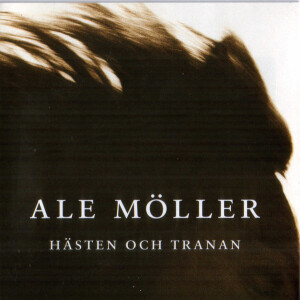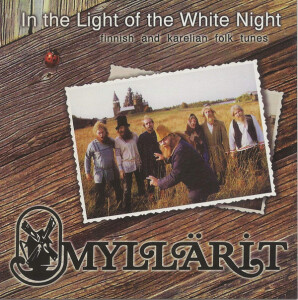 Brendan Foreman wrote this review for Folk Tales.
Brendan Foreman wrote this review for Folk Tales.
Ale Möller’s The Horse and the Crane is a thoroughly entertaining, thoroughly entrancing set of music made for a theatre concert based upon a set of novels by Sara Lidman about the extension of the railway into Northern Sweden. Filled with the stark instrumentation and ethereal sounds that seem to pervade the best Swedish music, this suite really does feel like the perfect soundtrack to a railway tour through glaciers.
To play this suite, Möller recruited an excellent cast of players. Möller himself a variety of instruments from the flute and hammered dulcimer to the octave mandolin and the lute. Roger Tallroth from Väsen plays guitar and mandolin, and Lena Willemark of Frifot fame sings and plays the fiddle and flute. On fiddle, there is Ellika Frisell; on double-bass, Olle Steinholz.
This is truly meant as “art music,” although some of the pieces here will have a familiar ring to any fan of Celtic or Nordic music. The second track “Humlan (the Bumblebee)” is a slowed-down reel with the strange modal minor chords that distinguishes a lot of Swedish music. “Glaspolskan (Glass Polska)” is a fairly standard though quite pretty polska. There are waltzes aplenty here as well.
What makes this CD so interesting is its unpredictability. “Vita Dimmer (White Mists)” begins with a sparse fiddle and guitar section over Lenna Willemark’s vocals, which expands into a three-part vocal section. Willemark’s solo vocals return for a few seconds before the track abruptly ends. Later, “Det Sjungande Berget (the Singing Mountain)” showcases Willemark’s surprisingly excellent shrieking ability. It’s a rather spooky track, bringing to mind images of shamans and hedge-witches, as actually do many of the pieces on this CD. Much later in the suite, things perk up with the joyful “Brollop (Wedding),” a free-for-all jam between bagpipes and hammered dulcimer. The CD ends with a grim little song called “Varifran Komma Barnen (Where Do the Children Come From).” It’s a slightly twisted piece that caps off this haunting set of music perfectly.
This is just picking a few examples from this CD, which has 22 amazing tracks in total. Taken as a whole, this CD becomes a complex and beguiling composition that conjures up the beauty and starkness of some of the best of traditional Swedish music.
This music – without any regard to the actual words – stands up perfectly well on its own. However, the lyrics – all written by Sara Lidman – are very poetic. Reading them, it’s very easy to see how Möller was inspired to write such glacial, almost primal music to accompany them.
 On the complete other end of Nordic music is that of Myllärit. Instead of the introspection and gloom of The Horse and the Crane, this Finnish seven-person ensembles offers danceability and joy on In the Light of the White Night, a fine selection of Finnish and Karelian folk tunes. These folk are as Old World in charm and sound as they come, giving us a smooth, elegant, and very evocative style of playing. In fact, like their compatriots Värttinä, they even manage to make polkas entertaining to non-dancers.
On the complete other end of Nordic music is that of Myllärit. Instead of the introspection and gloom of The Horse and the Crane, this Finnish seven-person ensembles offers danceability and joy on In the Light of the White Night, a fine selection of Finnish and Karelian folk tunes. These folk are as Old World in charm and sound as they come, giving us a smooth, elegant, and very evocative style of playing. In fact, like their compatriots Värttinä, they even manage to make polkas entertaining to non-dancers.
Tatyana Umnyakova on the fiddle and Sergey Zobnev on the accordion provide the main melodic base of most of these tunes with counterpoint and occasional melodies given by Dmitry Dyomin on clarinet, recorder and bagpipe. Backing these three up are Alexander Bykadorff, Arto Rinne, and Leo Sevets on guitars, mandolins, and other instruments as well as Andrey Lukin on drums. They play together as seamlessly as only long-time bandmates can.
Running the gamut from polka and polska to minuet and waltz, Myllärit cover all the usual dance forms with the spark and confidence of masters and the spunk and freshness of contemporary pop musicians. Hearing tunes like the sprightly “Tunteellinen Valssi (Sentimental Waltz)” or the comical “Osa Poika, Onni Poika (Lucky Fellow),” you’ll swear that you’ve just walked into a 19th century Old World bar, complete with a beautiful barmaid and drunken old veterans of the Napoleonic Wars. Even when they stray from their “traditional” field, such as the country-fried version of “Kahden Nuoren Rakkaus (love of two young things),” Myllärit are clearly having too much fun to hold it against them.
Taken together, these two recordings present a fascinating contrast. They both showcase different aspects of Nordic music – the frost-rimed starkness of Ale Möller’s Swedish-based sounds to the danceable charm of Myllärit’s Finnish and Karelian music – with completely contrasting approaches to the presentation of the music; Möller is writing music for a dramatic recital whereas Myllärit play music mostly for the bar and pub scene. It’s all good, though. In fact, I’d recommend getting both CDs just to see how varietous Nordic music can actually be.
(Northside, 1999)
(Finlandia Records, 1999)
